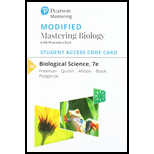
Concept explainers
To analyze:
The caloric content of whole milk and skim milk.
Introduction:
The milk consists of proteins, fatty acids, vitamins, energy compounds, inorganic elements, and water. Skim milk is the type of milk from which all the cream or milk fats have been removed. However, whole milk is the normal type of milk, which contains the proper amount of fat content. Skim milk contains 12 g (gram) carbohydrates and 8 g protein. Whole milk contains 12 g carbohydrates, 8 g protein, and 8 g fat.
Explanation of Solution
The calorie content of food is the amount of energy contained in a particular food. The calorie content is measured in kilocalories (kcal). The energy provided by fats is 9 kcal/g, and the energy provided by carbohydrates and proteins is 4 kcal/g each.
The caloric content of skim milk containing 12 g carbohydrates and 8 g protein can be calculated as follows:
Similarly,
Therefore, the total caloric content of skim milk is
The caloric content of whole milk containing 12 g carbohydrates, 8 g protein, and 8 g fat can be calculated as follows:
Similarly,
and
Therefore, the total caloric content of whole milk is
One serving of skim milk has approximately 80 kilocalories (kcal), while one serving of whole milk has about 152 kcal. The carbohydrates and proteins provide 4 kcal per gram (kcal/g), whereas fats provide 9 kcal/g.
Want to see more full solutions like this?
Chapter 41 Solutions
Modified Mastering Biology With Pearson Etext -- Standalone Access Card -- For Biological Science (7th Edition)
- Amino Acid Coclow TABle 3' Gly Phe Leu (G) (F) (L) 3- Val (V) Arg (R) Ser (S) Ala (A) Lys (K) CAG G Glu Asp (E) (D) Ser (S) CCCAGUCAGUCAGUCAG 0204 C U A G C Asn (N) G 4 A AGU C GU (5) AC C UGA A G5 C CUGACUGACUGACUGAC Thr (T) Met (M) lle £€ (1) U 4 G Tyr Σε (Y) U Cys (C) C A G Trp (W) 3' U C A Leu בוט His Pro (P) ££ (H) Gin (Q) Arg 흐름 (R) (L) Start Stop 8. Transcription and Translation Practice: (Video 10-1 and 10-2) A. Below is the sense strand of a DNA gene. Using the sense strand, create the antisense DNA strand and label the 5' and 3' ends. B. Use the antisense strand that you create in part A as a template to create the mRNA transcript of the gene and label the 5' and 3' ends. C. Translate the mRNA you produced in part B into the polypeptide sequence making sure to follow all the rules of translation. 5'-AGCATGACTAATAGTTGTTGAGCTGTC-3' (sense strand) 4arrow_forwardWhat is the structure and function of Eukaryotic cells, including their organelles? How are Eukaryotic cells different than Prokaryotic cells, in terms of evolution which form of the cell might have came first? How do Eukaryotic cells become malignant (cancerous)?arrow_forwardWhat are the roles of DNA and proteins inside of the cell? What are the building blocks or molecular components of the DNA and proteins? How are proteins produced within the cell? What connection is there between DNA, proteins, and the cell cycle? What is the relationship between DNA, proteins, and Cancer?arrow_forward
- please fill in the empty sports, thank you!arrow_forwardIn one paragraph show how atoms and they're structure are related to the structure of dna and proteins. Talk about what atoms are. what they're made of, why chemical bonding is important to DNA?arrow_forwardWhat are the structure and properties of atoms and chemical bonds (especially how they relate to DNA and proteins).arrow_forward
- The Sentinel Cell: Nature’s Answer to Cancer?arrow_forwardMolecular Biology Question You are working to characterize a novel protein in mice. Analysis shows that high levels of the primary transcript that codes for this protein are found in tissue from the brain, muscle, liver, and pancreas. However, an antibody that recognizes the C-terminal portion of the protein indicates that the protein is present in brain, muscle, and liver, but not in the pancreas. What is the most likely explanation for this result?arrow_forwardMolecular Biology Explain/discuss how “slow stop” and “quick/fast stop” mutants wereused to identify different protein involved in DNA replication in E. coli.arrow_forward
- Nutritional Sciences: From Fundamentals to Food, ...Health & NutritionISBN:9781337486415Author:McGuirePublisher:CengageHealth Safety And Nutrition F/Young ChildHealth & NutritionISBN:9781305144767Author:MAROTZPublisher:Cengage





